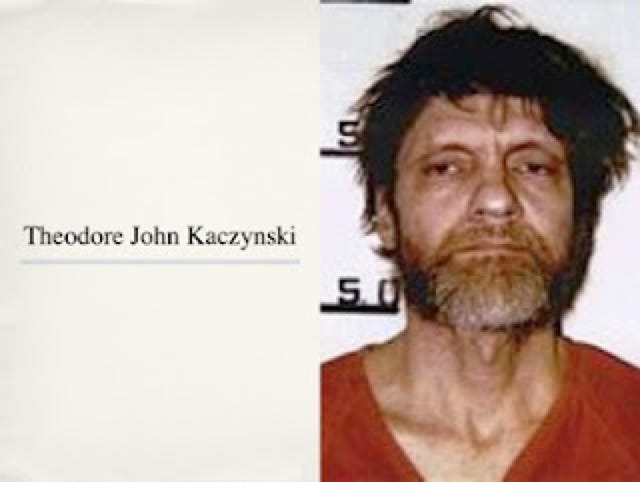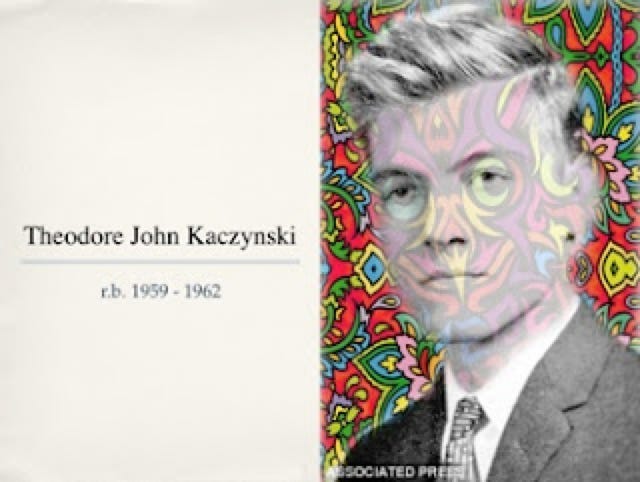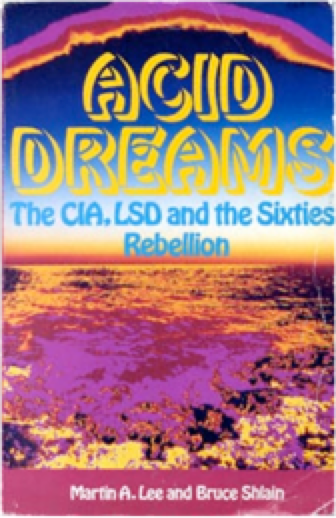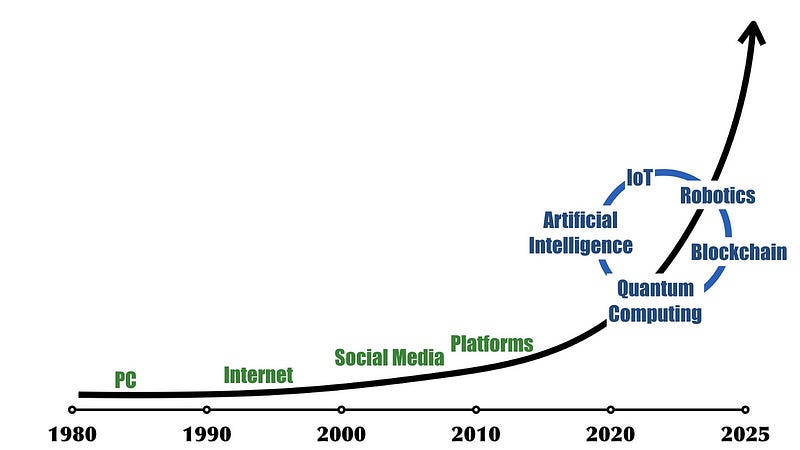Eulogy for the Unabomber
"You are the cultural programming subject the Unabomber was warning about."
When he learned that John Brown had been executed, Henry David Thoreau said, “Of all the men who are said to be my contemporaries, it seems to me that John Brown is the only one who has not died.”
Abolitionist John Brown led a raid on the federal arsenal at Harpers Ferry, Virginia (now in West Virginia), in 1859 that he hoped would spark a slave rebellion. Two of his sons died in the standoff, ended by US Marines under the command of General Robert E. Lee and Army Cavalry Lieutenant J. E. B. Stuart.
— Vicki Smith, John Brown’s legacy hasn’t changed; America has, Bay Street Banner
Less than a year after Brown’s hanging, the South seceded. Union forces marched to battle singing “John Brown’s body lies a-moldering in the grave while his soul keeps marching on” and with similar gusto, “He hath loosed the fateful lightening of His terrible swift sword; His truth is marching on,” remembering that Brown raided the Harpers Ferry Armory bearing swords to avoid alerting townspeople.
The armory was a large complex of buildings that contained 100,000 muskets and rifles, which Brown planned to seize and use to arm local slaves. They would then head south, drawing off more and more slaves from plantations, and fighting only in self-defense. As Douglass and Brown’s family testified, his strategy was essentially to deplete Virginia of its slaves, causing the institution to collapse in one county after another, until the movement spread into the South, wreaking havoc on the economic viability of the pro-slavery states.
— Wikipedia
The first casualty of the raid was a free black man, a baggage handler, who bled to death after being stabbed. Within 48 hours, the rebellion was just as dead, as were four civilians, 10 raiders and a U.S. Marine.
“John Brown was, in effect, a terrorist, whether you agree that what he was doing was right or not,” says Gerry Gaumer, spokesman for the Park Service in Washington, D.C. “There are people in the Taliban who believe what they’re doing is right. Can you separate John Brown from what’s going on in Iraq or Iran or Pakistan or Afghanistan?"
— Bay Street Banner
Times Change
It took more than a century for people to come around in their thinking about John Brown. The standard narrative I was taught in Connecticut grade school was that he was a misguided madman. Gradually that changed, to where those raised north of the Mason-Dixon line tend to see him favorably, while in the South he is at the root of the War of Northern Aggression. The conflict was explored by David Reynolds in his 2005 biography, John Brown, Abolitionist:
The early biographers were mainly people who had known Brown personally and who idolized him — they therefore twisted facts to make him seem heroic, at times godlike. In reaction, there arose a school of biographers intent upon exploding this saintly image. They swung to the other extreme of portraying him as little more than a cold-blooded murderer, horse thief, inflexible egotist, fanatical visionary, and shady businessman.
***
The cultural biographer explores the historical “air” surrounding the subject and describes the process by which the air seeped through the pores of his or her skin. “Great geniuses are parts of the times,” Melville wrote; “they themselves are the times, and possess a correspondent coloring.” Once the biographer accepts the cultural environment as a viable area of study, new vistas of information and insight open up. John Brown emerges in cultural biography not as an isolated, insane antislavery terrorist but as an amalgam of social currents-religious, reformist, racial, and political-that found explosive realization in him.
Dennis Frye, chief historian of Harpers Ferry National Historical Park, says Brown will remain “a perpetual enigma.”
“People emote when they think of John Brown. They’re not using their mind as much as their heart. They’re not using their brain as much as their soul,” Frye says. “They feel about John Brown. They either feel for him or they feel against him, but the key is they feel.”
Age of Limits
When I first proposed speaking about the Unabomber at the Age of Limits Conference in 2013, Orren Whiddon, the event’s founder, asked, “Why?”
I am puzzled with the Unabomber workshop [proposal], can you give me an idea of how it pertains? I am sure you are sick of talking about it, but a community workshop based on your experiences at The Farm would be good, could be combined with Patricia [Allison] and myself. Your thoughts. Other ideas?
I had become interested in Ted Kaczynski, the Unabomber, after listening to a reading of his famous manifesto on the C-realm Vault, and being struck by how relevant it was to the current malaise, the Occupy movement, and the age of chaotic collapse that comes after you ignore long-running and very serious warnings about ecological systems failure.
I told Whiddon that Ted Kaczynski was an extraordinary genius whose sense of human dignity was profoundly altered, at age 16, by being secretly made the subject of an MKULTRA mind control experiment while a child prodigy undergrad at Harvard. He was a casualty of the Cold War.
During the test, gifted students who volunteered for the program were taken into a room and connected to electrodes that monitored their physiological reactions, while facing bright lights and a one-way mirror. Then they were brutally confronted with their inner demons that they had provided the interrogators during months of screening tests. LSD or other drugs may have played a role.
This horrific experience fostered an abiding animus, not just in Ted Kaczynski, but in all the subjects, towards the secretive security state. It is a textbook example of the blowback that became so synonymous with Allen Dulles’s reign at CIA (indeed, with Allen Dulles’s whole life, since he was the low-level State Department clerk in Switzerland who, in 1916, stamped V.I. Lenin’s visa application to the United States, “Rejected.”)
Kaczynski’s commentary, the manifesto he called Industrial Society and Its Future, stands by itself as a benchmark in collapseology. The manifesto is a critique of leftism and US ad-age politics, but it is also a deep-thought exercise on why people are sheep, the mechanics of manufactured consent, who is doing the manipulation and why, and why, ultimately, there is likely no way out of our present dilemma apart from human extinction.
The manifesto does not discuss the letter bombings or Ted Kaczynski’s motivations for his 18-year campaign of terror, but if you consider the victims — a California computer store owner, a computer science professor at Yale, behavioral geneticists at UCal and MIT, the PR executive who managed the Exxon clean up of its public image after the Exxon Valdez, the president of a timber industry lobbying group — they are all connected to the narrative, which is a defense of wilderness and dignity against the oppressive industrial state and its portents of grey goo singularity. Kaczynski was a Luddite. He defined Luddism.
Here is the Unabomber many of us remember:
— an unkempt evil bomber. From 1978 to 1995, Kaczynski sent 16 bombs to targets including universities and airlines, killing three people and injuring 23. The media narrative is that he was a paranoid schizophrenic and that there is nothing more about him to interest us.
Kaczynski was born and raised in Chicago. With an IQ of 167, he was accepted to Harvard at 15. In graduate school at the University of Michigan, he worked in a field of mathematics so esoteric that a member of his dissertation committee estimated that only 10 or 12 people in the country understood it. He became a college professor at Berkeley in 1967, at age 25.
His assigned readings as a 16-year-old Harvard freshman included Margaret Mead (Coming of Age in Samoa), Ruth Benedict (Patterns of Culture), Sigmund Freud (The Future of an Illusion), Thorstein Veblen, Norbert Wiener, Lewis Mumford, Friedrich Nietzsche, Oswald Spengler, Joseph Conrad (Heart of Darkness, The Secret Agent), and Jacques Ellul (The Technological Society).
This machine-technics will end with the Faustian civilization and one day will lie in fragments, forgotten — our railways and steamships as dead as the Roman roads and the Chinese wall, our giant cities and skyscrapers in ruins like old Memphis and Babylon.
— Oswald Spengler
The message from Harvard’s 1950s freshman syllabus was a despairing depiction of the sinister forces that lie beneath the surface of civilization — witness the prior ten years — with emphasis on the alienation of the individual and on the threat that science poses to human values (Kristallnacht and the A-bomb). All these were in his assigned readings. And the frank rationale behind the curricula was, ironically enough, to socially engineer the elite of the next generation, not as nihilists, but as doubters, skeptics, and people unwilling to accept political, philosophical or religious dogma at face value. It was a 180° shift from the Harvard of years earlier. But, double irony either way, it represented elite-dictated culture, and that was the veil that LSD and dissociative sensory deprivation pierced (thank you, Dr. Leary).
We can no longer live, with the illusions of success, in a world given over to devitalized mechanisms, desocialized organisms, and depersonalized societies: a world that had lost its sense of the ultimate dignity of the person.
— Lewis Mumford
Montana Dreaming
Later, Kaczynski’s students at Michigan all said he was an excellent instructor, but the opposite was reported at Berkeley. His goal by then was not to teach, but to save up to get a cabin in Montana. Berkeley in the 60s was still very button-down and serious but with a strong cultural counter-current. The Free Speech Movement took place in Berkeley in 1964–65. It launched the political careers of later Attorney General Ed Meese, who conducted mass arrests of student protesters, and Ronald Reagan, who used white citizen backlash to become governor of California, his first elected office.At the time Kaczynski left California he still had some hope of achieving society-transformative goals by peaceful means. He built the cabin himself, lived with very little money, and was without electricity, telephone or running water. He studied tracking and edible plant identification and gained primitive skills. The ultimate catalyst that drove him to begin his bombings was when he went out for a walk to one of his favorite wild spots, only to find that it had been bulldozed and replaced with a Forest Service road. He stopped studying nature and began studying bomb-making.
As I see it, I don’t think there is any controlled or planned way in which we can dismantle the industrial system. I think that the only way we will get rid of it is if it breaks down and collapses.
— Ted Kaczynski
Ned Ludd may have been a fictional character but the Luddites were real. At one time, there were more British soldiers fighting the Luddites than fighting Napoleon on the Iberian Peninsula. The protests from 1811 to 1817 were against new labor-saving milling machinery, but the real spark was the hardships suffered by the working class. The popular myth is that the Luddites tried to prevent the Industrial Revolution. In fact, they were more akin to the Yellow Vests in Paris, Extinction Rebellion in Netherlands, or the Coronation protesters in London.
Kaczynski had to make a strategic decision. He could get his ideas published without killing everyone. If he were as strategic at book marketing as he was at serial killing, he would probably have had a best seller. He decided instead he needed to have real skin in the game. He needed to walk his talk about revolution versus reform. So he started selecting targets.
Morality is the herd instinct of the individual.
— Nietzsche
Kaczynski’s first bomb was sent in 1978 to a professor at Northwestern University. It injured a campus policeman. He sent bombs to airline officials and in 1979 came close to blowing up a commercial jetliner en route from Chicago to Washington DC. This is the point the FBI became involved and called him UNABOM for University and Airline Bomber. The FBI profiler characterized him as a “neo-Luddite holding an academic degree in the hard sciences.” Victims included an Air Force Captain, a computer science professor at Yale, a computer store owner, professors at Berkeley, Vanderbilt, Univ of Utah, U-Mich, a geneticist at MIT, and the public relations executive whose firm handled the ExxonValdez oil spill. His final bomb (3 dead and 23 injured) killed a forest industry lobbyist in 1995.
In 1995, he offered that if his 50-page essay Industrial Society and Its Future (abbreviated to “Unabomber Manifesto” by the FBI) were printed verbatim by a major newspaper or journal he would end his bombing campaign. The pamphlet was published by The New York Times and The Washington Post on September 19, 1995. He was captured when his brother recognized the writing style and called the FBI.
The premises of the entire manifesto are neatly summarized in the first few lines:
“The Industrial Revolution and its consequences have been a disaster for the human race.”
“The continued development of technology will worsen the situation.”
“There is no way of reforming or modifying the system so as to prevent it from depriving people of dignity and autonomy.”
After this, Kaczynski goes into why exactly a revolution, rather than peaceful evolution, is required. He criticizes the modern left for essentially being “House Niggers,” working to prop up the tyranny while being made to feel powerless and inferior. He criticizes intellectuals and anti-intellectuals, evangelists and moralizers for propagating memes of low self-esteem, depressive tendencies and defeatism that are at the root of conformism to a violent and self-destructive system. He criticizes the right saying “The conservatives are fools: They whine about the decay of traditional values, yet they enthusiastically support technological progress and economic growth. Apparently, it never occurs to them that you can’t make rapid, drastic changes in the technology and the economy of a society without causing rapid changes in all other aspects of the society as well and that such rapid changes inevitably break down traditional values.”
“If the system breaks down the consequences will still be very painful. But the bigger the system grows the more disastrous the results of its breakdown will be, so if it is to break down it had best break down sooner rather than later.”
The Power Process
At the core of the Manifesto is what Kaczynski calls the Power Process. He sees power as an instinctive need, and when we take away people’s ability to provide for themselves their own fundamental requirements and make them dependent on the society to provide those, people substitute surrogate activities, many, indeed most, of which are destructive of humanity, ecology, and society.
[I]n many or most cases, people who are deeply involved in surrogate activities are never satisfied, never at rest. Thus the money-maker constantly strives for more and more wealth… The long-distance runner drives himself to run always farther and faster. Many people who pursue surrogate activities will say that they get far more fulfillment from these activities than they do from the ‘mundane’ business of satisfying their biological needs, but that is because in our society the effort needed to satisfy the biological needs has been reduced to triviality.
We attribute the social and psychological problems of modern society to the fact that that society requires people to live under conditions radically different from those under which the human race evolved and to behave in ways that conflict with the patterns of behavior.
Among the abnormal conditions present in modern industrial society are excessive density of population, isolation of man from nature, excessive rapidity of social change and the breakdown of natural small-scale communities such as the extended family, the village or the tribe.
“Crowding, rapid change, and the breakdown of communities have been widely recognized as sources of social problems,” Kaczynski says, but people have gone through all of those things at various times and in various places and still retained their humanity and tribal cohesion. What industrial-technological society does that is different is to supplant the power process with a machine that demands uniformity and conformity and to remove the innate feel for what is real — what are the sources in nature for our food and water, for instance. This is the problem of artificial matrix reality, and it breeds ignorance of the dangers of gene splicing and nuclear power.
Kaczynski recognized decades before most people that rather than acknowledging that humans currently live in “conditions that make them terribly unhappy,” “the system” (i.e. industrial society) develops ways of controlling human responses to the overly stressful environment in which they find themselves; gives them the drugs to take away their unhappiness — television, videos, etc.
“If you think that big government interferes in your life too much NOW, just wait till the government starts regulating the genetic constitution of your children. Such regulation will inevitably follow the introduction of genetic engineering of human beings,” he wrote. An identical point was broached by Al Gore in his book, The Future, where he outlined China’s brain research and the prospect of genetically modified humans, like it or not. We are in a military race for the superintellect, Gore realizes, and, so apparently did Barack Obama, whose $100 million Human Brain Project put the USA into the Brain Race with China.
Until his suicide on June 10, 2023, Kaczynski was serving eight life sentences in a Colorado Supermax. His newer writings are stored at the Univ. of Michigan’s Special Collections Library, embargoed until 2049, assuming anyone is left to read them. His Montana cabin, transplanted board for board, is on display at the Newseum in Washington, D.C.
Ted Kaczynski has not yet been shown wrong. We don’t yet have compulsory genetic engineering (unless you consider nuclear energy) but we have GMO labs in many, if not most, high schools in the US, China and India. FabLabs or 3D printers can be accessed with a college student ID.
The weapons used by most of the random rampage killers in recent years have been based on gunpowder — a 7th-century invention. What happens when a disgruntled teenager gets his hands on a GM bacteria and the ability to insert that into a strand of recombinant DNA?
Was Ned Ludd right?
Like Brando’s Captain Kurtz in Apocalypse Now, Ted Kaczynski’s no-holds-barred take-it-all-down philosophy was shared by Rumsfeld & Cheney, Eric Prince and Cofer Black (hired from Black Industries to be Bush’s torture czar) and Wagner Group founder Yevgeny Prigozhin.
The difference between revolutionary violence and state-condoned violence is the difference between dog shit and cat shit.
— Tolstoy
Dr. M.L. King’s Letter from a Birmingham Jail (1963) gave four essential instructions for social reform:
In any nonviolent campaign there are four basic steps: collection of the facts to determine whether injustices exist; negotiation; self purification; and direct action.
Kaczynski went to great lengths to accomplish steps 1, 3 and 4. He repudiated step 2 as unethical and counterproductive.
Humans have apparently not reached peak capacity to conceive theories or philosophies that promote violence or murder. We justify violence in order to counter perceived injustices or to acquiesce in historical necessity. To soften the sick feeling in the pit of our stomach — a natural reaction of associating another’s pain as our own — we dehumanize our enemies. We become like Raskolnikov, in Crime and Punishment, who declares, “I did not kill a human being, but a principle!”
Guided by theories, philosophies, and ideologies, the worst mass killers of modern history transformed their victims into depersonalized abstractions, making them easier to kill. Stalin ordered the murder of millions of farmers toward “the elimination of the Kulaks as a class,” So Kaczynski rationalized his murders as necessary to solve “the technology problem.”
The conditions that produce violence, so well described by Kaczynski, continue to flourish. Despite their historically unprecedented affluence, many middle-class USAnians, particularly the educated elite, are still gripped by despair. They sleep restlessly. They tranq down and meth up. Teen suicide soars. The education system and popular culture from Game of Thrones to World War Z continue to promote bleak visions of the future. Winter is coming.
We, dear friends, feed this beast at our peril.
More is being posted on other sites about the Age of Limits conference and some of the controversies it stirred, but we’d venture to say that offering a deeper examination of Ted Kaczynski’s bombing campaign was likely one of the more controversial topics undertaken at that venue.
He forsook running water, read by the light of homemade candles, stopped filing federal tax returns and subsisted on rabbits. … The area was so remote that during an 18-day stakeout, one agent saw a cougar kill a deer.
***
According to New York magazine, Mr. Kaczynski’s papers became one of the collection’s most popular offerings. In an interview with the magazine, Julie Herrada, the collection’s curator, declined to describe the people so intrigued by Mr. Kaczynski that they visit the library to look through his archive. She said just one thing: “Nobody seems crazy.”
— The New York Times Obituary Desk, June 10, 2023
Why Kaczynski would take his life at 81 no-one can say. No powerful people wanted him dead like Jeffrey Epstein, John McAfee, Bernie Madoff, Whitey Bulger, or Paul Wellstone. He enjoyed a stimulating prison chat group with Ramzi Ahmed Yousef, who bombed the World Trade Center in 1993, and Timothy J. McVeigh, the Oklahoma City bomber. Is it possible the rise of Open AI, Chat GPT, and Bard might have set him off? Did he sense the Singularity approaching? If a guy with an acid-powered 167 IQ suddenly decides to check out, shouldn’t we wonder why?
When you see the disheveled arrest photos of Ted Kaczynski run beside the story of his suicide and the usual pablum about his bombing campaign without mention of MKULTRA, just remember, you are the cultural programming subject the Unabomber was warning about.
An earlier version of this essay appeared in The Great Change in June, 2013. https://peaksurfer.blogspot.com/2013/06/the-unibomber-in-age-of-limited-options.html
References
Kaczynski, T., Industrial Society and Its Future (1995) http://editions-hache.com/essais/pdf/kaczynski2.pdf
Reynolds, D., John Brown, Abolitionist: The Man Who Killed Slavery, Sparked the Civil War, and Seeded Civil Rights (Alfred A. Knopf 2005).
Meanwhile, let’s end this war. Towns, villages, and cities in Ukraine are being bombed every day. Ecovillages and permaculture farms have organized something like an underground railroad to shelter families fleeing the cities, either on a long-term basis or temporarily, as people wait for the best moments to cross the border to a safer place or to return to their homes if that becomes possible. There are 70 sites in Ukraine and 500 around the region. As you read this, we are sheltering some 2,000 adults and 450 children. We call our project “The Green Road.”
For most of the children refugees, this will be their first experience in ecovillage living. They will directly experience its wonders, skills, and safety. They may never want to go back. Those that do will carry the seeds within them of the better world they glimpsed through the eyes of a child.
Those wishing to make a tax-deductible gift can do so through Global Village Institute by going to http://PayPal.me/greenroad2022 or by directing donations to greenroad@thefarm.org.
There is more info on the Global Village Institute website at https://www.gvix.org/greenroad or read this recent article in Mother Jones. Thank you for your help.
The COVID-19 pandemic destroyed lives, livelihoods, and economies. But it has not slowed climate change, a juggernaut threat to all life, humans included. We had a trial run at emergency problem-solving on a global scale with COVID — and we failed. 6.88 million people, and counting, have died. We ignored well-laid plans to isolate and contact trace early cases; overloaded our ICUs; parked morgue trucks on the streets; incinerated bodies until the smoke obscured our cities as much as the raging wildfires. The modern world took a masterclass in how abysmally, unbelievably, shockingly bad we could fail, despite our amazing science, vast wealth, and singular talents as a species.
Having failed so dramatically, so convincingly, with such breathtaking ineptitude, do we imagine we will now do better with climate? Having demonstrated such extreme disorientation in the face of a few simple strands of RNA, do we imagine we can call upon some magic power that will arrest all our planetary-ecosystem-destroying activities?
As the world emerges into pandemic recovery (maybe), there is growing recognition that we must learn to do better. We must chart a pathway to a new carbon economy that goes beyond zero emissions and runs the industrial carbon cycle backward — taking CO2 from the atmosphere and ocean, turning it into coal and oil, and burying it in the ground. The triple bottom line of this new economy is antifragility, regeneration, and resilience. We must lead by good examples; carrots, not sticks; ecovillages, not carbon indulgences. We must attract a broad swath of people to this work by honoring it, rewarding it, and making it fun. That is our challenge now.
Help me get my blog posted every week. All Patreon donations and Blogger or Substack subscriptions are needed and welcomed. You are how we make this happen. Your contributions are being made to Global Village Institute, a tax-deductible 501(c)(3) charity. PowerUp! donors on Patreon get an autographed book off each first press run. Please help if you can.
Thank you for reading The Great Change.
The Great Change is a reader-supported publication. To receive new posts and support my work, consider becoming a free or paid subscriber.











Comments